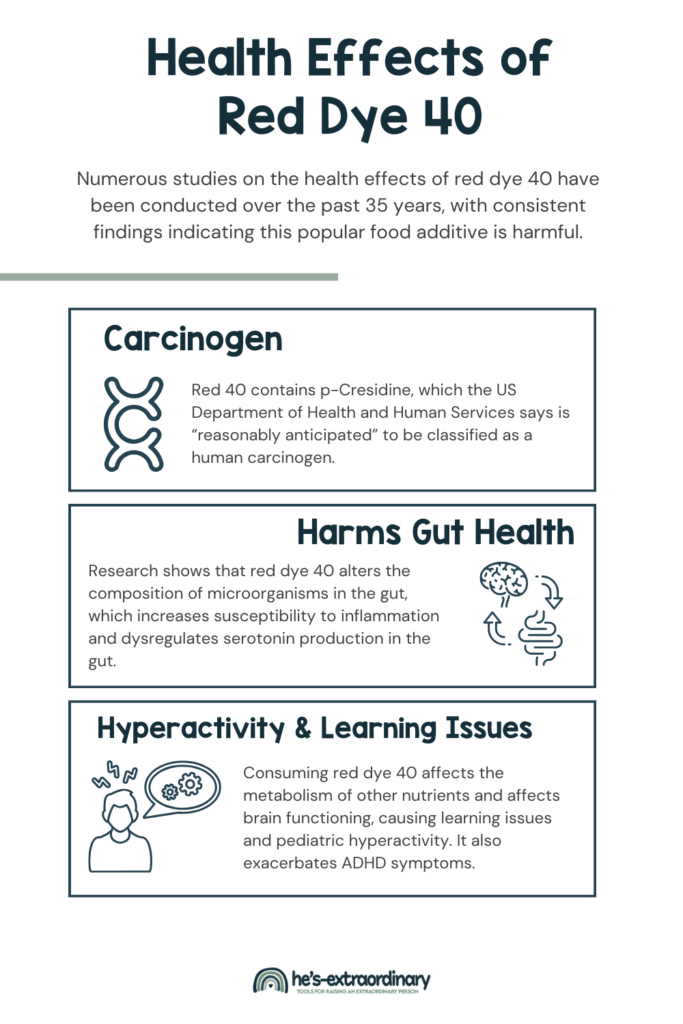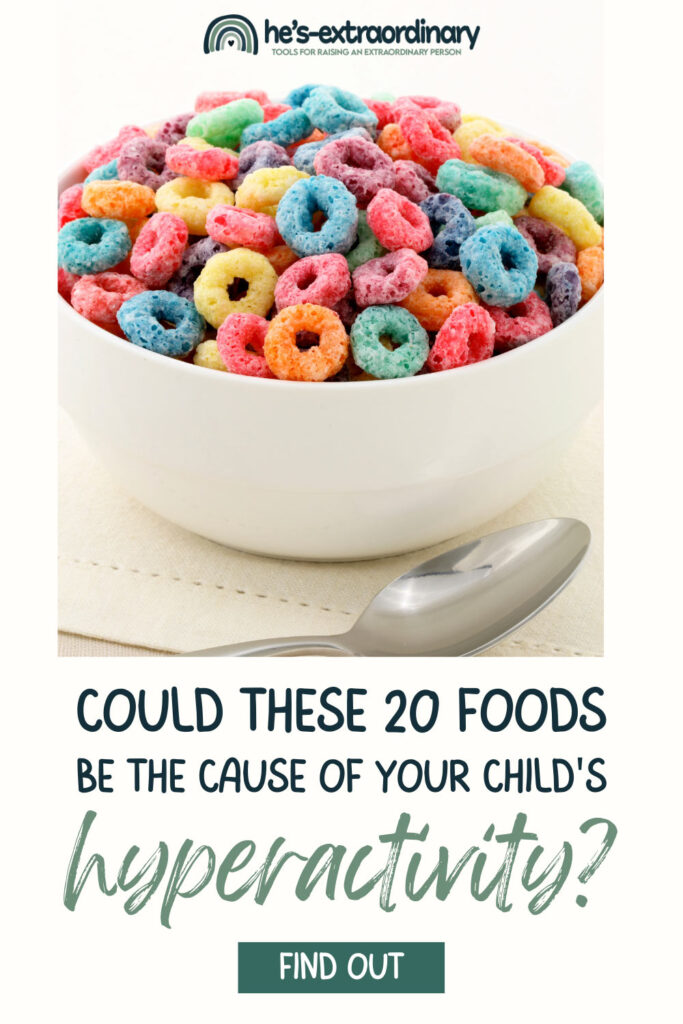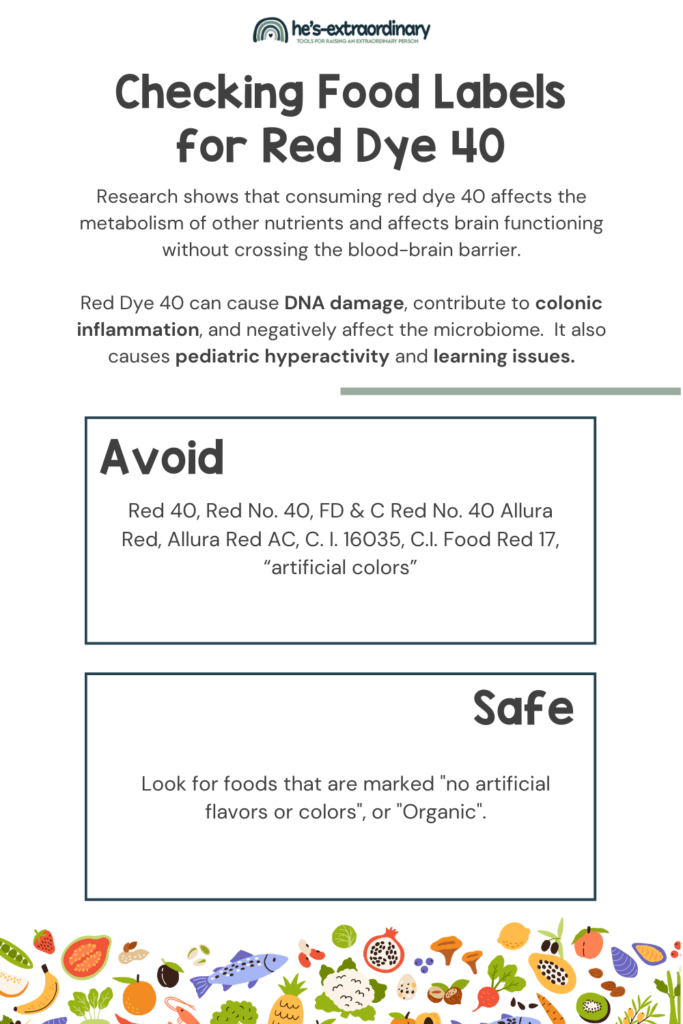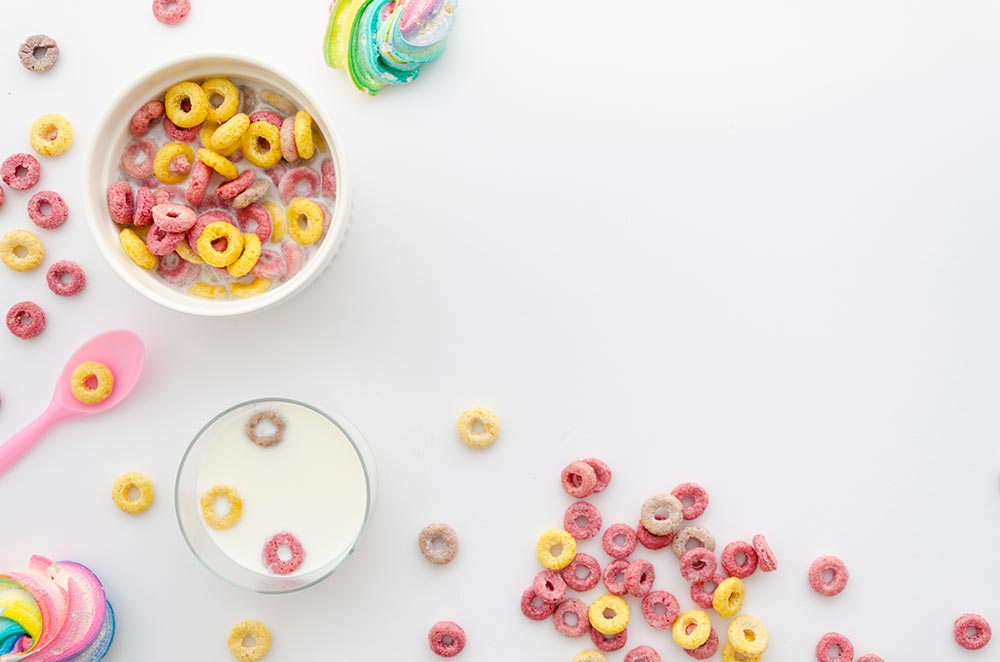Is Red Dye 40 The Cause of Your Child’s Hyperactivity?
What’s inside this article: A look into current research on artificial food colors and how they affect children’s behavior, including a list of popular (and some surprising) foods containing red dye-40.
Disclaimer: This post contains affiliate links.
Currently, research is raising more and more concerns regarding red dye 40 and other artificial food colors.
The National Institute of Health (NIH) believes that current scientific research is “too substantial to dismiss,” but more research into red dye 40 needs to be conducted to understand its effects fully.
This post contains:
- What we currently know about red dye 40 and other artificial food colors
- How it affects children’s behavior, particularly those with an ADHD diagnosis
- Which popular foods contain red dye 40.
- Which foods are safe to eat
What is Red Dye 40?
Red Dye 40, also known as Allura Red AC, is a synthetic food dye that belongs to the azo dye class. It is one of the most commonly used food dyes in the United States and many other parts of the world.
Red Dye 40 comes from coal tars. Coal tar is a thick dark liquid by-product of burning coal (like during the production of petroleum products).
Dyes made from coal tars are created by mixing various fragrant-smelling hydrocarbons like benzyne and toluene.
Benezynes are sweet-smelling chemicals derived from natural gases and crude oil. Toluene is a solvent used in paints, lacquers, thinners, glues, correction fluid, and nail polish remover.
Uses for Red Dye 40:
Red Dye 40 is water-soluble, making it very versatile for use in a range of products.
Manufacturers use this artificial food color to give a bright, attractive red color to various food products, beverages, candies, cosmetics, and even some medications.
However, it’s also known to turn up in less surprising places—for example, chocolate pudding.
Although the US Food and Drug Administration (FDA) has deemed it safe for use in food within specified limits, Norway, Finland, France, Austria, the UK, and several other European countries have banned Red Dye 40 due to the growing evidence of its harmfulness.
Research Findings on Red Dye 40: Harmful Effects on DNA, Gut Health and Behavior in Children
Current research into the safety and potentially harmful effects of Red Dye 40 has produced findings that raise concerns about its impact on health.
Doctors have theorized since the 1920s that red dye and other artificial food colors could affect child behavior. But, no real research was conducted until pediatric allergist Dr. Benjamin Feingold presented the findings from his patients in 1973.
Since 1965, he’d been having his patients with ADHD follow a special diet that contained no artificial food colors. At the time, he claimed that 60-70% of his patients no longer met the diagnostic threshold for ADHD once they changed their diet.
So, what was going on with his patients? Research shows that consuming red dye 40 affects the metabolism of other nutrients and affects brain functioning without crossing the blood-brain barrier. (Source)
A study published in 2023 has indicated that Red Dye 40 can cause DNA damage, contribute to colonic inflammation, and negatively affect the microbiome. The research highlights the potential role of Red Dye 40 in developing early-onset colorectal cancer (EOCRC), given its prevalence in ultra-processed and pro-inflammatory foods, which are particularly appealing to children. (Source)
Also, Red 40 contains p-Cresidine, which the US Department of Health and Human Services says is “reasonably anticipated” to be classified as a human carcinogen.

Artificial Food Colors Don’t Cause ADHD – They Cause Pediatric Hyperactivity, Learning Challenges & Harms Gut Health
The research isn’t suggesting that artificial food colors like red dye 40 are causing ADHD. It’s believed that red dye and other artificial food colors cause pediatric hyperactivity and learning issues.
ADHD is a quantitative diagnosis. So, for some children, the effects of red dye can push them over the threshold for an ADHD diagnosis. Artificial food colors can also exacerbate ADHD symptoms, so symptoms become more manageable once they are eliminated from a child’s diet.
Consumption of red dye 40 has quadrupled in the last 50 years.
Additionally, research shows red dye 40 alters the composition of microorganisms in the gut, leading to increased susceptibility to inflammation (Source). It also dysregulates serotonin production in the gut.
Serotonin is a key neurotransmitter that, while commonly associated with brain function, is predominantly produced in the gut. It plays a crucial role in regulating mood, appetite, and digestion.

Popular Kids’ Foods with Red Dye 40
Unfortunately, this is a pretty popular food additive in kids’ food. If your child is a picky eater, they might currently be consuming quite a bit of this harmful dye.
I’ve been checking food labels since learning about the effects of artificial colors.
Here are some of the foods I’ve found that contain red dye 40.
- Captain Crunch
- Trix
- Fruity Pebbles
- Lucky Charms
- Poptarts
- Toaster Strudels
- M&Ms
- Reese’s Pieces
- Strawberry Twizzlers
- Skittles
- Jellybeans
- Chocolate Pudding
- Doritos
- Fruit Rollups
- Motts Applesauce
- Powerade
- Kool-Aid
- Crush Orange
- Some pickles
- Some BBQ sauces and other condiments
What to look for on your food labels:
Red dye 40 has a few different aliases, so check your food labels. If you see any of the following in the ingredient list, the product contains red dye 40.
- Red 40
- Red No. 40
- FD & C Red No. 40
- FD and C Red No. 40
- Allura Red
- Allura Red AC
- C. I. 16035
- C.I. Food Red 17

Are you Canadian?
Fortunately, in the United States, companies are required under the FDA to label dyes used under the list of ingredients.
However, regulations are a little more relaxed in Canada. In Canada, they simply need to report “colours”. So, if you’re in Canada, you should check your labels and avoid anything containing artificial colors.
Safe Foods
So what’s safe to eat? When grocery shopping – look for foods that are marked “no artificial flavors or colors”, or “Organic”.
Some safe foods:
- Nutella
- Bear Paws
- Cheerios
- Annies Bunny Fruit Snacks
- Annies Cheddar Bunnies
- All whole foods – i.e. fruits, vegetables, raw nuts
- Anything labeled organic
Popular Organic Food Brands
- Kashi – They carry a huge variety of bars, cereals, waffles, and more
- Nature’s Path – A Canadian, family-run company. They have many bars, cereals, oatmeals, and cookies. They also have an “Envirokidz” line of products made specifically for children.
- Love Grown – Love Grown has some fun, fruity cereals and chocolatey cereals for kids that are completely organic and safe to eat.
- Made Good – Gluten-free, organic oat snacks.
- Kind – Protein bars, chewy kids bars, whole-fruit snacks, and more
- Larabar – Fruits and greens, chocolates, brownies, cereal bars – they have tons of flavor choices
- Simply – A new line of products from Fritos Lays that offers organic versions of their popular products like Doritos, Cheetos, potato chips, etc.
Hopefully, this list offers a viable alternative for some of your children’s favorite snacks. I know how hard it can be to find foods your child will eat if they’re picky or have sensory issues.
Have you tried this diet?
If you’ve eliminated artificial food colors or solely red dye 40 from your family’s diet, I would love to hear from you.
Share your experience and favorite products in the comments. It will be super helpful for other parents looking for more information.

